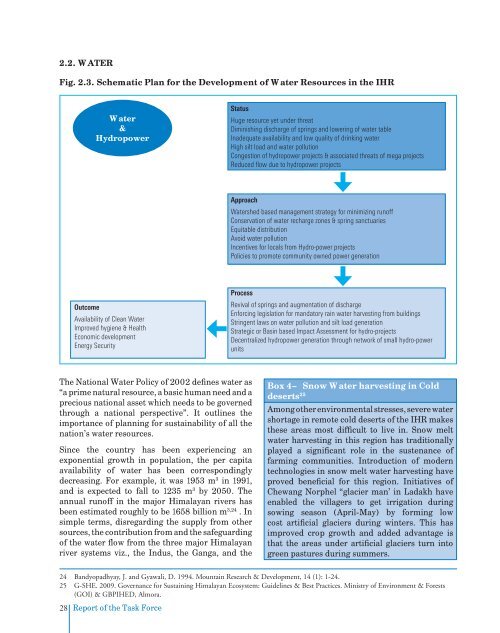Task Force Report - Govind Ballabh Pant Institute of Himalayan ...
Task Force Report - Govind Ballabh Pant Institute of Himalayan ...
Task Force Report - Govind Ballabh Pant Institute of Himalayan ...
Create successful ePaper yourself
Turn your PDF publications into a flip-book with our unique Google optimized e-Paper software.
2.2. WATER<br />
Fig. 2.3. Schematic Plan for the Development <strong>of</strong> Water Resources in the IHR<br />
Water<br />
&<br />
Hydropower<br />
Status<br />
Huge resource yet under threat<br />
Diminishing discharge <strong>of</strong> springs and lowering <strong>of</strong> water table<br />
Inadequate availability and low quality <strong>of</strong> drinking water<br />
High silt load and water pollution<br />
Congestion <strong>of</strong> hydropower projects & associated threats <strong>of</strong> mega projects<br />
Reduced flow due to hydropower projects<br />
Approach<br />
Watershed based management strategy for minimizing run<strong>of</strong>f<br />
Conservation <strong>of</strong> water recharge zones & spring sanctuaries<br />
Equitable distribution<br />
Avoid water pollution<br />
Incentives for locals from Hydro-power projects<br />
Policies to promote community owned power generation<br />
Outcome<br />
Availability <strong>of</strong> Clean Water<br />
Improved hygiene & Health<br />
Economic development<br />
Energy Security<br />
Process<br />
Revival <strong>of</strong> springs and augmentation <strong>of</strong> discharge<br />
Enforcing legislation for mandatory rain water harvesting from buildings<br />
Stringent laws on water pollution and silt load generation<br />
Strategic or Basin based Impact Assessment for hydro-projects<br />
Decentralized hydropower generation through network <strong>of</strong> small hydro-power<br />
units<br />
The National Water Policy <strong>of</strong> 2002 defines water as<br />
“a prime natural resource, a basic human need and a<br />
precious national asset which needs to be governed<br />
through a national perspective”. It outlines the<br />
importance <strong>of</strong> planning for sustainability <strong>of</strong> all the<br />
nation’s water resources.<br />
Since the country has been experiencing an<br />
exponential growth in population, the per capita<br />
availability <strong>of</strong> water has been correspondingly<br />
decreasing. For example, it was 1953 m 3 in 1991,<br />
and is expected to fall to 1235 m 3 by 2050. The<br />
annual run<strong>of</strong>f in the major <strong>Himalayan</strong> rivers has<br />
been estimated roughly to be 1658 billion m 3,24 . In<br />
simple terms, disregarding the supply from other<br />
sources, the contribution from and the safeguarding<br />
<strong>of</strong> the water flow from the three major <strong>Himalayan</strong><br />
river systems viz., the Indus, the Ganga, and the<br />
Box 4– Snow Water harvesting in Cold<br />
deserts 25<br />
Among other environmental stresses, severe water<br />
shortage in remote cold deserts <strong>of</strong> the IHR makes<br />
these areas most difficult to live in. Snow melt<br />
water harvesting in this region has traditionally<br />
played a significant role in the sustenance <strong>of</strong><br />
farming communities. Introduction <strong>of</strong> modern<br />
technologies in snow melt water harvesting have<br />
proved beneficial for this region. Initiatives <strong>of</strong><br />
Chewang Norphel “glacier man’ in Ladakh have<br />
enabled the villagers to get irrigation during<br />
sowing season (April-May) by forming low<br />
cost artificial glaciers during winters. This has<br />
improved crop growth and added advantage is<br />
that the areas under artificial glaciers turn into<br />
green pastures during summers.<br />
24 Bandyopadhyay, J. and Gyawali, D. 1994. Mountain Research & Development, 14 (1): 1-24.<br />
25 G-SHE. 2009. Governance for Sustaining <strong>Himalayan</strong> Ecosystem: Guidelines & Best Practices. Ministry <strong>of</strong> Environment & Forests<br />
(GOI) & GBPIHED, Almora.<br />
28 <strong>Report</strong> <strong>of</strong> the <strong>Task</strong> <strong>Force</strong>

















